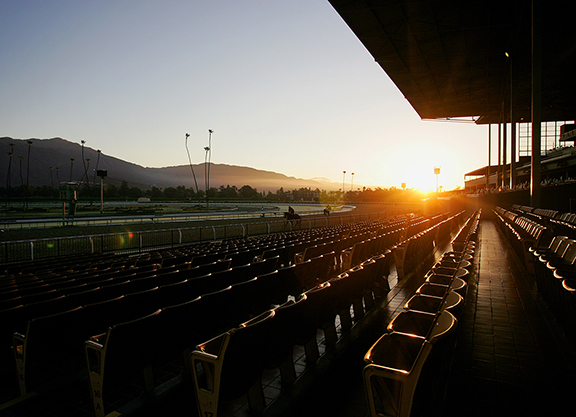By Dan Ross
Brice Blanc is rested, swabbed, needled and raring to go.
“It'll be good to get back to work,” said the jockey, who's scheduled to ride Friday at Santa Anita before a grandstand empty of spectators–the track's first day of live racing since March 22.
To get the green-light to ride, Blanc underwent a blood test Wednesday to see whether he carries antibodies showing that he's already been exposed to Covid-19. He was also given a nasal swab to see if he's currently infectious.
“It wasn't that bad,” said Blanc, of the swab procedure. “Tickled a bit, that's all.”
Blanc attended a meeting at the track Thursday for the jockeys, who were walked through the steps that would be taken moving forward.
As had been announced previously, the jockeys, valets and other “essential personnel” permitted to enter the frontside of the track, who by the nature of their role are unable to practice social distancing, will be housed during live racing days in trailers.
This “restricted zone” is situated behind the jock's room, two people in each trailer, said Blanc.
“If you don't ride for a few races, and you want to go to your trailer you can go–it's right within walking distance,” said Blanc. “They're really nice, actually. It's what the movie people get.”
The track has also implemented saddling and pre-race protocols to keep separate the backstretch community from the front side. These protocols were listed in a document issued by track management to the horsemen Thursday afternoon and comprising 12 key components, which are as follows:
- All horsemen and women, employees and essential racing personnel must wear face cloths covering their nose and mouth and practice social distancing while at Santa Anita.
- All horsemen and women, employees and essential racing personnel must wear a race day wristband while onsite, signifying they passed the daily health screening at Santa Anita, including a temperature check.
- Grooms with appropriate race day wristbands will bring horses to the receiving barn. Race day grooms that will be accompanying a horse should stop by the stable gate prior to bringing over their horse to receive a race day wristband.
- Trainers will be allowed in the receiving barn to saddle their horses with non-restricted valets. a. Trainers will watch races from area of the grandstand in a specific area assigned by their horse's number.
- Grooms will take their horses to the walking ring. Trainers will be allowed to watch their horses from the outside of the walking ring. Trainers will watch the race from a specific area of the grandstand assigned by their horse's number.
- Jockeys will be legged up onto horse by a restricted valet just after horse enters the walking ring.
- Each pony rider will pick up horse from groom just east of the saddling barn path and go directly out to the track. a. Grooms will watch their race from an area of the walking ring in a specific area assigned by their horse's number.
- Horse and jockey will take part in the post parade, warm up and race.
- Winning horse will not go into the winner's circle but should stop at the finish line prior to exiting the track for a “Winner's Circle Photo” with the winning horse and jockey. The winning horse will exit the track through the tunnel with the other runners, accompanied by the pony riders.
- Grooms will be staged at physically distant intervals on the walking ring to meet their horses. Jockeys will dismount, untack their mounts and return to the jockeys' room to weigh in. Grooms will lead the horses to the test barn or back to their own barns.
- Ponies and pony riders will go to the saddling barn for water, shade and await the next race.
- This plan mandates physical distancing and the use of PPE as recommended by the CDC.
The track coordinated a prototype rehearsal of this system last week. As has been routine during the suspension of live racing at the track, trainers and backstretch employees have been required to take temperature checks each morning.
According to Aidan Butler, executive director of California Racing Operations for The Stronach Group, the jockeys, valets and other staff required to remain in the “restricted zone” will be able to return home after racing ends Sunday.
These personnel are expected to undergo another round of tests before being allowed to return the following week. Butler stressed how these protocols will invariably be tweaked and streamlined, including an attempt to find a Covid-19 test that's less invasive than the current nasal swab.
“It feels like you're having the back of your brains scooped out,” said Butler of the procedure, adding that he and senior vice president, Nate Newby, will be joining the jockeys and valets in the “restricted zone” during live racing. “You can't ask everybody else to do something you're not willing to do yourself.”
Not a subscriber? Click here to sign up for the daily PDF or alerts.






